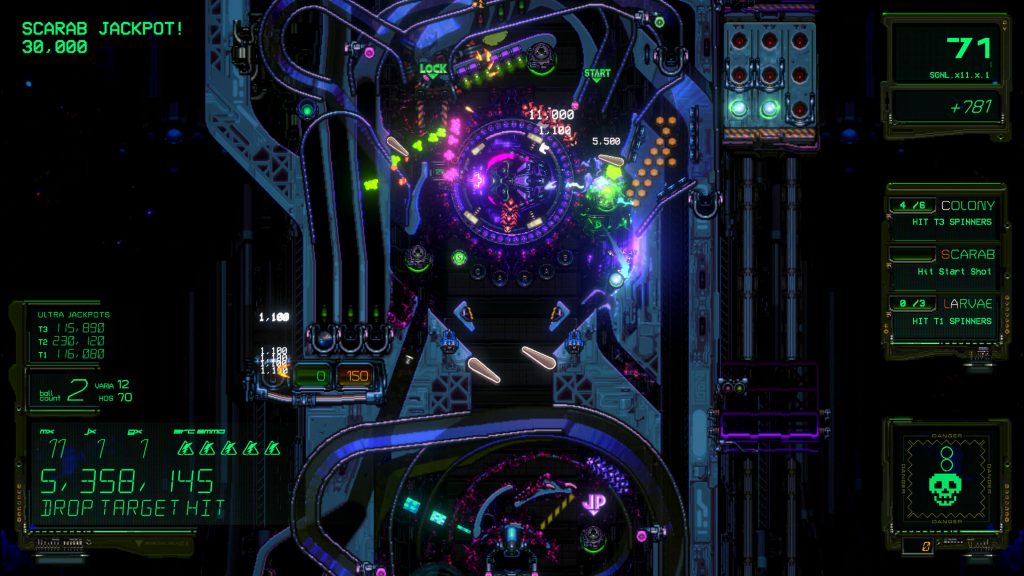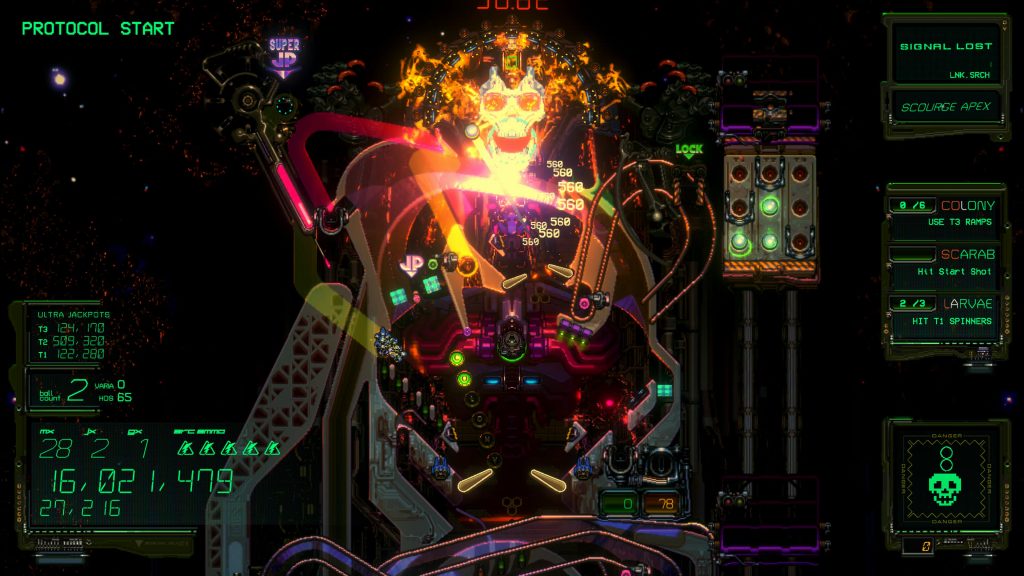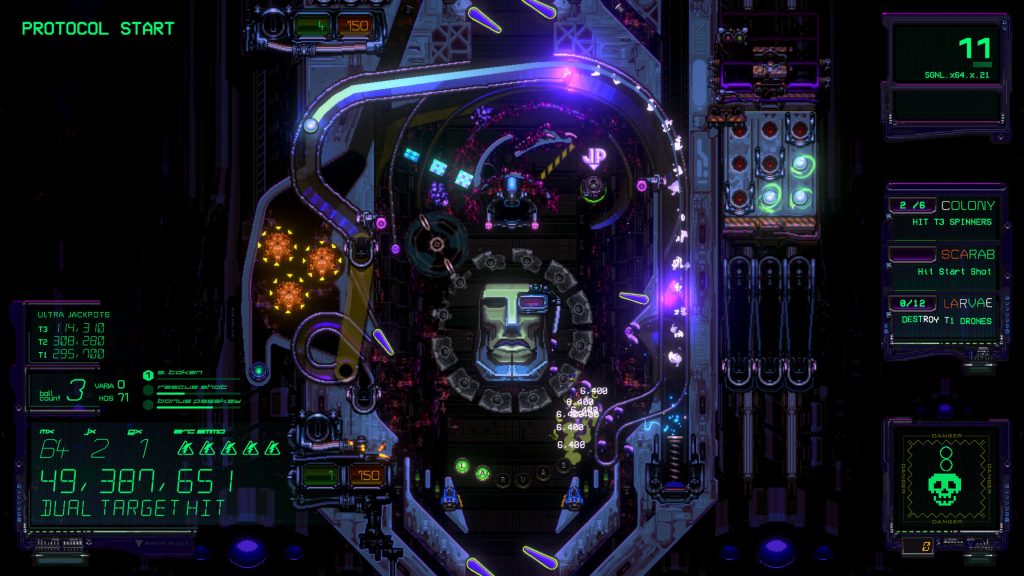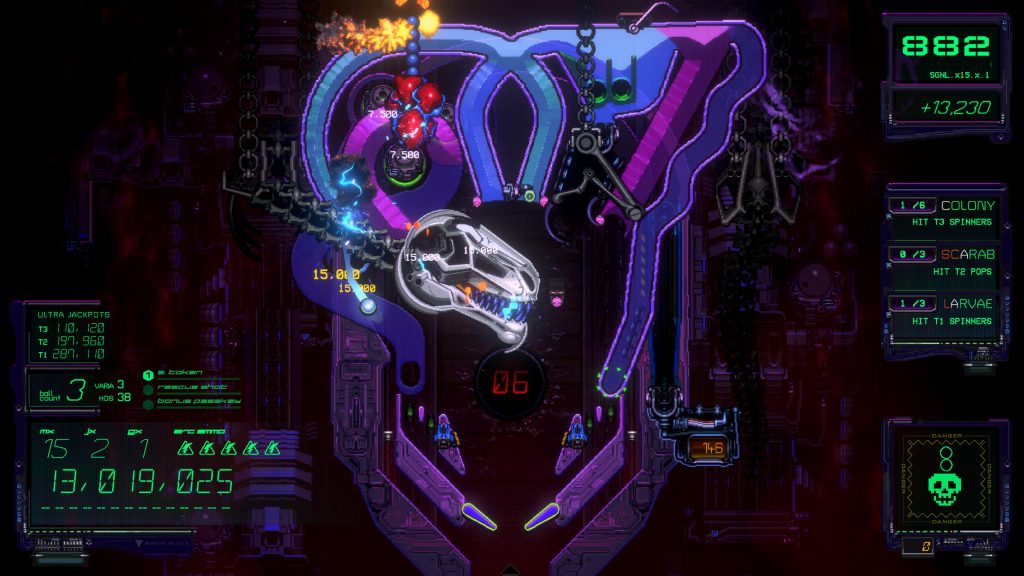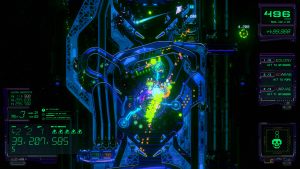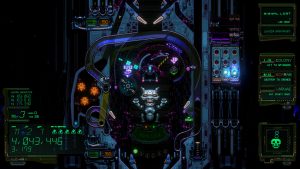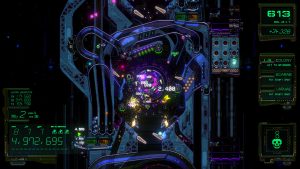Xenotilt, or to give its full name, XENOTILT: HOSTILE PINBALL ACTION, is an arcade-style pinball title from LA-based studio FLARB LLC (Flarb?!) which somehow manages to both modernise the genre while also taking it back to its earliest videogame roots.
The pinball scene, in videogaming, has been ruled for years now by Zen Software and their Pinball FX series and, we have to admit, we ended up all a bit fatigued from it. From the seemingly endless numbers of new tables to the disappointment of 2003’s Pinball FX essentially asking you to re-buy your entire collection for seemingly no real upgrade. Even Pinball M‘s horror-themed spin-off just felt like an unnecessary final course in a meal that’s already got you feeling overstuffed.
But Xenotilt‘s approach to the genre is wholly different. A follow up to Demon’s Tilt, this game offers you one table but with a futuristic cyberpunk/biomech setting. And from the point where you launch your first ball, you’ll be trying to figure out all the many complexities of a table that far outstrips anything you’ll have been used to in terms of things to do and discover.
With its busy, modern look and dramatic lighting, its clear that Xenotilt is going all out to impress and take things forward but, as we said before, it’s got one foot firmly planted in the past. So, if you’re old like us, you’ll remember that pinball games back in the day were 2D affairs with a strict aerial view of the table, as opposed to having seven different 3D angles to choose from as you do with modern pinball titles. And that’s the case here, you get one straight-on view, from above, of the table.
However, the other big gimmick that actually comes from gaming history is the fact that this table has three sections, essentially three tables in one. This might be quite novel to younger gamers but if you ever played Kirby’s Pinball Land on the original Gameboy (and you should, it’s fantastic) or Timescanners on arcade/home computers of the ’80s, you’ll have seen this trick done before.
One thing Xenotilt doesn’t do is explain itself. Sure, there are little bits of visual information presented without much context, but you may find your early goes of this game quite frustrating. It’s hard to know what to do, where to look or what you should be working towards. But essentially each section of the table has its own objectives. These usually involve hitting targets, travelling through ramps or destroying things. When your goal is ‘DESTROY 6 T3 DRONES’ you’ll have no idea what they are but the T refers to which tier of the table they are on and the drones, spinners and other targets you’ll need to identify yourself.
When you complete an objective you’ll get a wizard point which will drop a ball into a 3×3 matrix and will give you a perk. It’s not really very clear at all and we ended up watching a one hour playthrough/tutorial on YouTube as without it we felt a bit lost. But anyway, that’s what you need to do.
To complicate things further, you’ll get enemies appearing whose job is to block your ball or deflect it. It’s hard enough to know what you’re meant to hit without some bastard sprite getting in the way and throwing off your aim. This is where your turrets come in. Again, the game doesn’t explain it brilliantly but you know that thing where you hold down the flipper button to catch the ball? Well, doing that will fire your turrets and that’ll clear the immediate area for you. There’s a bit of complexity when it comes to getting ammo for them, but that’s the general idea anyway.
There are also additional modes that add various quirks to the gameplay including one that’s more of a rogue-lite sort of thing and others that put extra bosses and sub-areas into the game. So there’s quite a lot to do here, even if the game is only offering you the one main table.
Looking online, the reception to this game has been very positive. People love the eye-melting visuals and the addictive complexity of it. We’re not 100% sold though. Those visuals do come at the sacrifice of clarity and with the camera view already being a bit squinty and the lighting not doing you a ton of favours either, it’s not always that easy to see what’s going on. This is compounded by the fact that you rarely get a chance to look across the screen to figure out what your next objective is.
On the plus side, the game is still pretty playable and the off-ramps and gaps aren’t too aggressive. Compared to the Williams tables on Pinball FX, things are a lot fairer here. That said, your flippers do feel a bit stubby and there’s more of a focus on tilting than we’d prefer with certain ramps/targets almost relying on the use of the technique. But overall there’s a lot of fun to be had with Xenotilt, even if we’re not entirely convinced by the multitude of accolades the game is getting elsewhere.
+ The new abilities and upgrades add some depth
+ Cool visual style
+ Not bogged down by too much content
- It's hard to know what you're meant to be doing initially
- Just one table (albeit in three sections)


